Abstract
References
- [1]Sanıvar, N.,Woodworking Surface Finishing, National Education Printing House, İstanbul 2001.
- [2] Kantay R.; Kartal N; Heat process practices and properties of heat treated wooden material. Wooden Magazine, 33:36-42 (2007).
- [3] Thermoodwood Handbook 2003. Finnish Thermowood Association, Helsinki , Finland .
- [4] Budakçı, M., “The eefects of layer thickness in varnish to brillance, hardness and resistance of stick, Master thesis, Gazi University, Graduate School of Natural and Applied Sciences, Ankara,(1997).
- [5] Highley, T.L., Kıcle, T.K., Phytopsthology (Blanchette, R.A., et al.,), (1990).
- [6] Atar, M., “Effects on the surface treatment of Color-opening chemical substances in wooden material, Ph. D. Thesis, Gazi University, Graduate School of Natural and Applied Sciences, Ankara,15-17 (1999).
- [7] Sogutlu, C, “The using of some native wood species in kundekari construction. Ph. D. Thesis, Gazi University, Graduate School of Natural and Applied Sciences, 101-102 (1504) (2004), Ankara.
- [8] Ozalp, M. (2008) The investigation of borax pentahydrate influences with double components in varnish applications of wood materials’’, Wood Res.,53(4): 121-128.
- [9] Ozalp, M., Korkut, S. (2011) The research of borax pentahydrate effects with water-based double components in varnish applications of wooden materials’’, Wood Res., 56(1), : 105-114.
- [10] ASTM D 358 ‘’Standard Specification for Wood to Be Used as Panels in Weathering Tests of Coatings’’ American Society for Testing and Materials, 5-9 (1998).
- [11] ASTM D-4541., “Standard Test Method for Pull-Off Strength of Coatings Using Portable Adhesion Testers”, American Society for Testing and Materials, 12-15 (1995).
- [12] TS EN 24624., “Paints and varnishes - Pulling Test”, Ankara, (1996)
- [13] ANS/IS01522., “Paints and Varnishes-Pendulum Damping Test Approved as an American National Standard by ASTM International", (1998).
- [14] TS 4318 EN ISO 2813, Paint and varnishes- nonmetallic paint films determining the brillance in 20°, 60° and 85°, TSE, Ankara, (2002).
Investigation of The Effects of Heat Treatment On Varnished Wood Material
Abstract
In this study, the effects of the heat treatment applied varnished wood materials on hardness, brightness and varnishes’ surface sticking resistance were investigated. For this purpose, firstly Pinus Sylvestris L., Fagus Orientalis L. and Castanea Sativa M. wooden samples were varnished by the water based varnish and after that they were kept in temperatures of 100 ˚C, 125 ˚C and 150 ˚C for times of 2, 4 and 6 hours. According to test results it was determined that while the hardness and varnishes’ surface sticking resistance were improved for all samples which were processed 2 hours in temperatures of 100 ˚C, the brightness, surface sticking resistance and brightness of the samples which were processed 4 and 6 hours in 100 ˚C and 2, 4 and 6 hours in 125 ˚C and 150 ˚C were deteriorated. Furthermore, it was observed that the hardness resistance of all samples which processed for 2, 4 and 6 hours in 100 ˚C, 125 ˚C and 150 ˚C were high. In all varnished wood species, the dual-component varnish gave better results than the single-component varnish.
References
- [1]Sanıvar, N.,Woodworking Surface Finishing, National Education Printing House, İstanbul 2001.
- [2] Kantay R.; Kartal N; Heat process practices and properties of heat treated wooden material. Wooden Magazine, 33:36-42 (2007).
- [3] Thermoodwood Handbook 2003. Finnish Thermowood Association, Helsinki , Finland .
- [4] Budakçı, M., “The eefects of layer thickness in varnish to brillance, hardness and resistance of stick, Master thesis, Gazi University, Graduate School of Natural and Applied Sciences, Ankara,(1997).
- [5] Highley, T.L., Kıcle, T.K., Phytopsthology (Blanchette, R.A., et al.,), (1990).
- [6] Atar, M., “Effects on the surface treatment of Color-opening chemical substances in wooden material, Ph. D. Thesis, Gazi University, Graduate School of Natural and Applied Sciences, Ankara,15-17 (1999).
- [7] Sogutlu, C, “The using of some native wood species in kundekari construction. Ph. D. Thesis, Gazi University, Graduate School of Natural and Applied Sciences, 101-102 (1504) (2004), Ankara.
- [8] Ozalp, M. (2008) The investigation of borax pentahydrate influences with double components in varnish applications of wood materials’’, Wood Res.,53(4): 121-128.
- [9] Ozalp, M., Korkut, S. (2011) The research of borax pentahydrate effects with water-based double components in varnish applications of wooden materials’’, Wood Res., 56(1), : 105-114.
- [10] ASTM D 358 ‘’Standard Specification for Wood to Be Used as Panels in Weathering Tests of Coatings’’ American Society for Testing and Materials, 5-9 (1998).
- [11] ASTM D-4541., “Standard Test Method for Pull-Off Strength of Coatings Using Portable Adhesion Testers”, American Society for Testing and Materials, 12-15 (1995).
- [12] TS EN 24624., “Paints and varnishes - Pulling Test”, Ankara, (1996)
- [13] ANS/IS01522., “Paints and Varnishes-Pendulum Damping Test Approved as an American National Standard by ASTM International", (1998).
- [14] TS 4318 EN ISO 2813, Paint and varnishes- nonmetallic paint films determining the brillance in 20°, 60° and 85°, TSE, Ankara, (2002).
Details
| Primary Language | English |
|---|---|
| Subjects | Engineering |
| Journal Section | Research Articles |
| Authors | |
| Publication Date | March 31, 2021 |
| Acceptance Date | February 6, 2021 |
| Published in Issue | Year 2021 Volume: 5 Issue: 1 |


